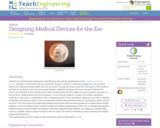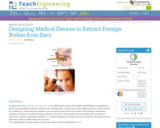
Students are introduced to engineering, specifically to biomedical engineering and the engineering design process, through a short lecture and an associated hands-on activity in which they design their own medical devices for retrieving foreign bodies from the ear canal. Through the lesson, they learn the basics of ear anatomy and how ear infections occur and are treated. Besides antibiotic treatment, the most common treatment for chronic ear infections is the insertion of ear tubes to drain fluid from the middle ear space to relieve pressure on the ear drum. Medical devices for this procedure, a very common children's surgery, are limited, sometimes resulting in unnecessary complications from a simple procedure. Thus, biomedical engineers must think creatively to develop new solutions (that is, new and improved medical devices/instruments) for inserting ear tubes into the ear drum. The class learns the engineering design process from this ear tube example of a medical device design problem. In the associated activity, students explore biomedical engineering on their own by designing prototype medical devices to solve another ear problem commonly experienced by children: the lodging of a foreign body (such as a pebble, bead or popcorn kernel) in the ear canal. The activity concludes by teams sharing and verbally analyzing their devices.
- Subject:
- Applied Science
- Engineering
- Health, Medicine and Nursing
- Material Type:
- Lesson Plan
- Provider:
- TeachEngineering
- Provider Set:
- TeachEngineering
- Author:
- Derek Harbin
- Krista Warner
- Leyf Starling
- Shayn Peirce-Cottler
- Date Added:
- 09/18/2014
